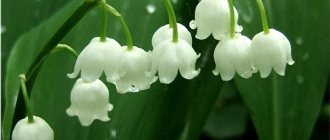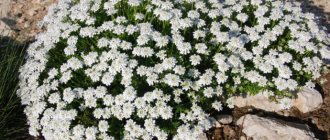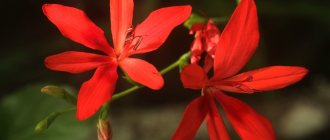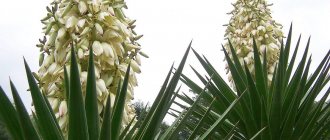general information
This culture is widespread in the temperate climate zone, in the northern hemisphere, although some of its varieties are also found in the tundra or forest-tundra zones. Lily of the valley as a genus includes some perennial plants with well-developed, branched, cord-shaped roots. They are often used for forcing in winter.
Today, garden lily of the valley has become quite popular among summer residents. He found his place in secluded and slightly darkened corners of the plots. It is usually planted in large groups. Many people use lily of the valley as a ground cover plant under trees or shrubs. It is known that this flower is rarely used in flower beds or mixborders, since it is somewhat aggressive and can displace its neighbors.
In the landscape
The large garden lily of the valley combines very beautifully with ferns, lungworts, columbine and anemones. However, you should not dig up and bring home forest varieties of this plant. According to many, the garden lily of the valley looks much more effective. Photos of this flower can often be seen in the form of a very simple but elite bouquet, including a wedding bouquet. For this purpose, half-blooming flower stalks are selected. At the same time, experts recommend not cutting them off, but simply pulling them out. However, you need to remember that almost all varieties of lily of the valley are distinguished by the secretion of milky juice, and therefore it is better not to combine them in bouquets with other flowers.
Description
The plant is very widespread not only in our country, but in Europe and Northern Asia. It is also found in North America.

The lily of the valley genus is a low-growing crop. Its representatives have creeping branched rhizomes, from which the upper, green part extends. The pale lower leaves are located in the soil, while the terrestrial vaginal leaves have a long, wide shape with a pointed apex. They are arranged in groups of four to six.
The upper surface of the leaves is matte, while the lower surface is shiny. The plant has a triangular stem, growing in height in some species up to fifteen to twenty centimeters. However, in some cases it can reach 40 cm, such as the tall garden lily of the valley. It contains white flowers, the corolla of which is made up of six fused petals. The most common variety found in the wild is the May lily of the valley.
Photo of lily of the valley
May lily of the valley
(Convallaria majalis) is the only species of the Lily of the Valley genus of the Liliaceae family.
High quality photo of lily of the valley. To view and download free pictures of lilies of the valley, click on the photo you like.
Click on the picture to view a high-quality photo
“Lilies of the valley - bright May greetings”...Who in Russia doesn’t know this cute little flower? They sing songs about it, make up legends, and give it as a sign of love and tenderness. The name of this flower translated from ancient Latin means “lily of the valleys” (Lilium convallium). The flower has the same meaning in English - Lily of the Valley. In Russia, this fragile, modest flower is called lily of the valley. There are several versions of the origin of this unusual flower name. According to one version, lily of the valley received this name among the people because its leaves resemble doe ears. According to another version, the word “lily of the valley” comes from the word “smooth”. Initially, the plant was called “smooth”, then they began to call it “lily of the valley”, and then the letter “g” was lost, and the flower began to be called lily of the valley
The legends associated with the origin of the lily of the valley are no less interesting than the origin of the name of the flower itself. Many of these legends are, in one way or another, associated with the onset of spring. For example, the lily of the valley was considered the flower of the goddess of spring and the rising sun, Ostara, who was greatly revered by the ancient Germans. In Rus', the flower was associated with the names of Sadko, Volkhov and Lyubava. Sadko, whom the sea princess Volkhova fell deeply in love with, gave his heart to Lyubava, the darling of forests and fields. Then Volkhova began to cry out of sadness, and lilies of the valley grew from her tears. Another legend tells of the bitter love of Lily of the Valley for Vesna, who shed tears when his beloved left. According to Christian legend, lilies of the valley grew from the tears of the Virgin Mary when she mourned the crucified Christ.
In North America, lilies of the valley were considered sacred flowers by the Indians who lived in what is now Massachusetts. Scientists are still arguing about how the flower got there. In the West, lily of the valley grows only in Massachusetts. Today, the lily of the valley is one of three symbols of this state (the others are the gull and the elm).
Lily of the valley began to be grown around the middle of the 16th century. The delicate, fragile flower was popular among young girls. In France, the flower was especially loved. The French even had a special holiday dedicated to lilies of the valley, which was celebrated on the first Sunday of May. In Moscow, in turn, the first sellers of lilies of the valley appeared only at the end of the 18th century. It was then that the lily of the valley was appreciated. In the 19th century, the beneficial properties of lily of the valley were discovered. Research was carried out on this flower, and in 1881, a special tincture was made from lily of the valley flowers, which was used against heart diseases.
Today, lily of the valley is gradually disappearing from the wild, and therefore is listed in the Red Book. However, in Russia, lilies of the valley are found quite often and are very popular among women and girls.
Garden views
Several garden varieties have been bred from the plant through selection, differing not only in the characteristics of the flowers, but also in the shape of the leaves. The stem of the plant is also a peduncle. Despite its height, the wide leaves are attached by means of sheaths, which are white or pink, and therefore they seem to bend towards the ground.
The garden lily of the valley with its inflorescence resembles a brush, on which small drooping flowers, numbering from five to twenty pieces, are placed on one side. At first glance, they look very similar to miniature bells, pointing downwards. Despite such small sizes, garden lily of the valley exudes a very pleasant and delicate aroma that can spread quite far.
Another variety is very common in the Caucasus - Transcaucasian, or Convallaria transcaucasica. It is frost-hardy and grows well in cultivation. For normal development of this species, a shaded area is required.
In the southern regions of the Far East you can find another variety of May lily of the valley, called “keizke”. It differs from the main species in dark green large leaves, as well as larger flowers and a late growing season.
May “snow whites” - lilies of the valley – 12 photos
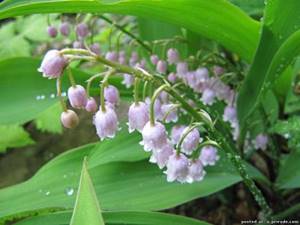
Lily of the valley is admired, admired, surprised, and people always want to know everything interesting about the lily of the valley. Since this flower has been known for a long time, we will talk about what is interesting about lily of the valley. Lily of the valley has always been a symbol of purity, tenderness, fidelity, and love.
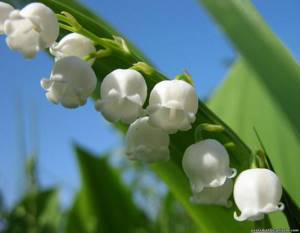
It turns out that the lily of the valley used to be the emblem of the doctor of medicine. So, as a sign of medical merit, people were presented with lilies of the valley. Therefore, in some old portraits we can see Nicolaus Copernicus with a bouquet of lilies of the valley in his hand. He was an excellent astronomer, and few people know that he was also an excellent doctor.
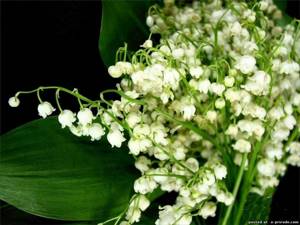
Since ancient times, it was believed that lily of the valley could cure all diseases. It was used in folk medicine as a remedy for paralysis, edema, fever, eye disease, and heart disease. Lily of the valley leaves in the form of tea were used as a diuretic. Lily of the valley is used not only in folk medicine. So in 1881, in the clinic of Professor S.P. Botkin began to use a tincture of lily of the valley flowers; it was used for heart diseases.

The North American Indians who live in Massachusetts consider the lily of the valley to be a hanging flower, and it is also a symbol of the state. There are two mysteries left: how the lily of the valley got to the Western Hemisphere, and why it grows only in this state. Answering the first riddle, scientists suggested that the lily of the valley was brought from Europe, but scientists could not answer the second riddle, because the lily of the valley reproduces very well and quickly, why it did not grow in other states is a mystery. This flower is very mysterious.
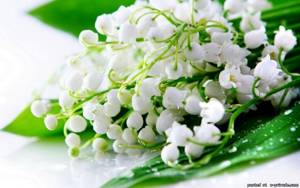
Lily of the valley leaves, like sharp spears, appear first on the surface of the earth, and then unfold in the form of a funnel. The leaves feed themselves perfectly, like a funnel, the water flows straight down to the root. Between two large leaves, the lily of the valley has a stalk strewn with pearls, fragrant with a unique delicate aroma. This is probably how you can describe lily of the valley.
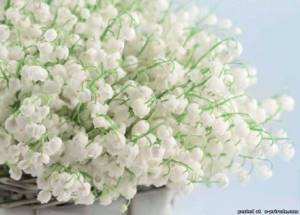
The French also admire the beauty of this flower; starting from the 17th century, they celebrate the Lily of the Valley Festival, which is held on the last Sunday of April. There used to be very interesting traditions. First, the youth went to the forest to pick up flowers, then everything was decorated with flowers, and the most important thing in this holiday was feasting and dancing. During the invitation to dance, first the young people exchanged bouquets of lilies of the valley, and then danced.

A bouquet of lilies of the valley was a modest gift and marriage proposal to a young man. If the bride agreed to the marriage, she simply pinned this bouquet on her chest; if the bride rejected the proposal, it was enough to throw a bouquet of lilies of the valley on the ground. In the East, with the help of flowers, lovers could communicate with each other. So in the eastern language of flowers, lily of the valley meant: “For a long time and secretly I love you.”

Not only the young loved this flower. Flower growers were also interested in lily of the valley. It is known that lily of the valley was bred in Egypt along with roses and gillyflowers back in the 1st century BC. Lilies of the valley grew there all year round. Lily of the valley has different names in different countries. For example, the Bulgarians call the lily of the valley a girl’s tear, the Czechs and Slovaks call the lily of the valley “konvalinka”, and the Germans call this flower the May bell.
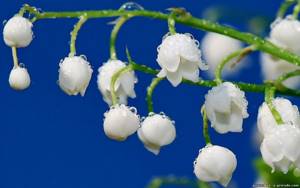
Lilies of the valley are loved in different countries, even on the coats of arms of some cities they use images of this flower, for example: in Sweden - the city of Mellerud, in Germany - the city of Weilara, in Norway - the city of Lunner. Lily of the valley has long been associated with purity and tenderness.
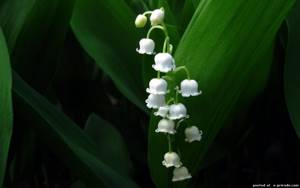
Of course, such a charming flower cannot leave many people indifferent, but for lily of the valley this is a problem. Almost every person definitely wants to bring a bouquet of lilies of the valley from the forest and continue to admire this beauty at home. But many people do not know how delicate this flower is; if even a small part of the rhizome is damaged, then the lilies of the valley will disappear from the entire clearing! Lilies of the valley are listed in the Red Book. Be attentive to this miracle of nature!
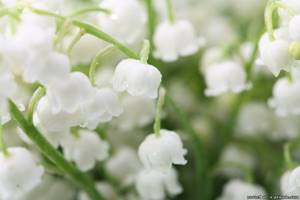
Reproduction of articles and photographs is permitted only with a hyperlink to the site:
| Photo of birch in summer | Kitten with green eyes | Pictures of fold kittens |
| British kittens 2 months photo | Kitten and tulips in a vase | Orchid Flower clip art |
| Orchids photo | Funny cats wallpaper | fright |
| Poppies high resolution photo | Summer wallpaper | Photo decorative sunflower |
Growing
Despite the fact that this plant grows mainly in forests, especially in shady meadows, many amateur gardeners today widely use it as a cultivated species. The first mention of the plant dates back to the mid-sixteenth century. Even then, garden lily of the valley began to be grown in Europe. Planting and caring for it does not require special skills, however, this flower must be handled very carefully, since the pleasant aroma that comes from it is very deceptive. The fact is that lily of the valley, including garden ones, is considered a poisonous plant. It is used only in medicine and less often in cosmetology.
Although garden species have a certain similarity with their “wild” relatives, they are nevertheless distinguished by the color of the leaves - green-yellow, as well as the color of the flowers. Their attractiveness lies in the fact that even after they have finished blooming, they still retain their decorative qualities provided by their large green leaves. However, in order for them to always be healthy and delight with their lush flowers, when growing them you should follow the rules that are required for a plant such as garden lily of the valley.
Planting and care in the garden
Accommodation:
The ideal place for lilies of the valley is a slightly shaded area, for example, under trees and along bushes, which will protect the flower from bright sunlight and winds. However, a location that is too dark will result in no flowering.
The soil:
Suitable soil for growing lilies of the valley is well-drained, light or medium loamy, moist, slightly acidic soil (pH 5). Good results can also be achieved with neutral buds.
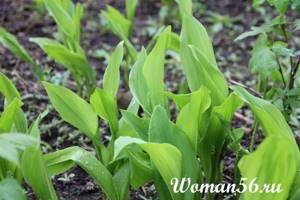
How to plant lilies of the valley if the soil is highly acidic?
In this case, distribute 200-300 grams of lime per 1 square meter. Additionally, to improve the soil structure, add about 10 kg of humus or peat compost, about 100 g of superphosphate, 40 g of potassium sulfate per area of the same area. In the summer, it is good to plant this place with legumes, which grow strongly and prevent overgrowing by weeds.
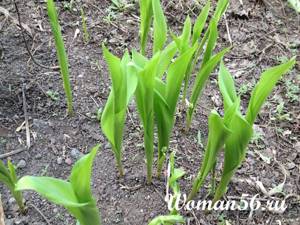
Lily of the valley Photo
How to plant lilies of the valley
It is advisable to prepare the soil a year before breeding, planting and caring for lilies of the valley. To prevent strong growth of lilies of the valley, you can fence off the area for planting them, using any available material about 20 cm high (sheets of slate or iron). This will be enough, since the powerful root system grows mainly in width and only 4-8 cm in depth.
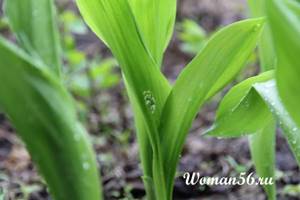
Lily of the valley Photo
Now about how to plant lilies of the valley correctly. The preliminary procedure is loosening the soil and preparing grooves up to 15 cm deep. A small part of the rhizome is planted so that the shoot can be covered with soil 1-2 cm, no more.
When planting, maintain a distance of about 8-10 cm, and between rows up to 25 cm.
Related article: Planting flowers in autumn: what flowers are planted, planting bulbs and seeds
If all the features of agricultural technology are observed, lilies of the valley will grow and bloom well in the same area for up to 10 years.
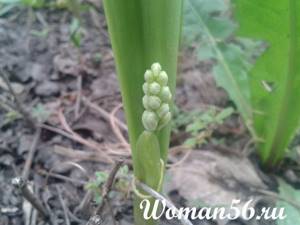
Lily of the valley Photo
Fertilizer for lilies of the valley
Propagation of lilies of the valley, planting and care require the application of fertilizer regularly at each stage. It is recommended to do this once every 14 days in spring and summer, during the growth period. Humus (on top of the soil) or mineral fertilizers are suitable as fertilizing.
Reproduction of lilies of the valley
Lily of the valley is best propagated by dividing the rhizome in August. To do this, segments 3-6 cm long will be separated from it, making sure that each has shoots and one or more apical buds. The bud should be straight and with a slightly sharp tip. The plant will bloom when at least 3 leaves appear, 2 years after planting. The method of propagation by seeds is not particularly effective, because the seeds have very low germination.
Caring for lilies of the valley
The growth and development of lilies of the valley is also positively influenced by timely watering, which maintains the soil in a constantly moist state. Insufficient moisture in dry summer weather will cause the plant to grow small, and flowering is unlikely to occur the next year. Lily of the valley has good winter hardiness, so in the cold season they do without shelter.
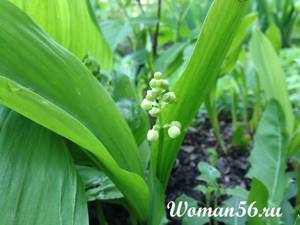
Lily of the valley Photo
Pests and diseases
When growing lilies of the valley, as with other plants and flowers, the question arises: “How to plant lilies of the valley if there is a risk of them being affected by diseases and pests?” The answer is the same in any case - you should think in advance about certain measures to protect the plant and combat them and try to regularly inspect the flowers. Nematodes can greatly damage the root system. Plants affected by this pest suffer from weak growth and eventually die.
Measures should be taken in advance, otherwise the affected plant will have to be disposed of. Nemocytades, developed specifically for this purpose, are suitable as a prophylactic agent. It is also useful to immerse the sprouts in hot water at a temperature of 43°C, which will destroy the pest. The gnawed leaves of the plant are the result of the activity of sawflies. Insecticides will help in the fight against them. Rainy weather and excess nitrogen in fertilizers contribute to the appearance of gray rot on plants that grow in open ground.
All parts of the plant are affected - the peduncle, the leaves, and the flowers.
Planting and care
Photos of this amazingly delicate flower can be seen in almost every gardening magazine. And this is not surprising: its snow-white graceful miniature bells evoke a feeling of tenderness and some kind of childish delight.
In order for the garden lily of the valley, which is easy to care for, to feel good on the site, you first need to choose the right place. Planting should be done in semi- or full shade. The soil should be slightly loamy, fairly moist and slightly acidic, although the plant feels good on neutral soil. Preparing the site for planting should begin somewhere in mid-autumn - in October.
The ideal time for placing outdoors is autumn (September) or spring (mid-April). Moreover, in the first case, planting should begin after the leaves on the trees turn yellow. The place should be chosen in the shade. The easiest way to plant lily of the valley is by sprouts, although propagation by seeds is often practiced. Planting material is small sprouts that have rhizome processes and leaf primordia or flower buds. Before placing them in the ground, thoroughly loosening them, you need to make grooves in it up to fifteen centimeters deep. During the planting process, you need to carefully ensure that the roots do not bend, and the sprouts themselves should be sprinkled with soil two to three centimeters.
Lilies of the valley: planting and care in the garden
Author: Natalya February 21, 2021 Category: Garden plants
Lily of the valley (lat. Convallaria) is a monotypic or oligotypic (including a small number of species) genus of the Asparagus family. Not so long ago, the lily of the valley flower was classified as a member of the Lily family or allocated to the Lily of the Valley family. The Latin name Lilium convallium, which was given to the plant by Carl Linnaeus, translates as “lily of the valleys.” The Russian name “lily of the valley” most likely came from the Polish language, and this plant is also called rejuvenator, rejuvenator, culprit and shirt. In the wild, lily of the valley is a forest flower; it grows in Europe, Asia and North America in deciduous, pine, mixed forests and floodplain oak forests.
Lily of the valley has been cultivated since the 16th century; in some towns in France, on the first Sunday in May, a lily of the valley festival is held. The healing properties of lily of the valley have been known since time immemorial and are still used in both traditional and folk medicine. Lily of the valley is also in demand in the perfume industry for creating fragrances.
Features of planting and growing
Planting material should be planted in rows, at a distance of ten centimeters between seedlings and thirty centimeters between rows. If the lily of the valley was correctly placed in the ground, then it will grow in this area for at least ten years.
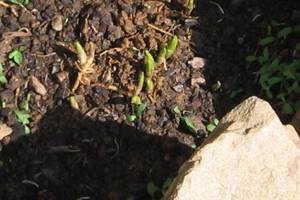
Moreover, in the first year after planting, only those sprouts with a diameter of more than six millimeters and a slightly rounded top will bloom. The rest will only have leaves.
A young garden lily of the valley, planted and cared for in accordance with agricultural standards, will only need to be covered with rotted manure. When the planted sprouts take root, and this happens around the thirtieth day, you should fertilize with organic fertilizers.
Planting and caring for lilies of the valley
- Planting: from September to early November.
- Flowering: April-May.
- Lighting: partial shade, shadow.
- Soil: moist, rich in organic matter, neutral or slightly acidic.
- Watering: only in abnormally hot times.
- Top dressing: humus or rotted manure, solutions of organic or mineral fertilizers.
- Reproduction: mainly by dividing rhizomes, less often by seeds.
- Pests: sawflies, nematodes, onion borers.
- Diseases: gray vegetable rot, gleosporiasis.
- Properties: lily of the valley is poisonous.
Forcing
For lush flowering, lilies of the valley need forcing. To do this, you need to dig up the plant immediately after frost. Rhizomes for forcing are selected with leaf ovaries. The shortest and thickest specimens, with the presence of blunt buds, are planted in pots, and the rest are returned to the garden bed.

In the fall, they are kept at home in soil with a nutrient composition. The pots are placed in a cool place where they are kept until January. The room temperature should be no higher than four degrees Celsius. In early February, the pots are transferred to a windowsill with diffused lighting. From this time on, the lily of the valley, starting to prepare for flowering, increases its leaf mass. In order for the plant to bloom faster, it must be covered with snow overnight before being brought into the room.
Watering
The plant needs constant moisture, otherwise it will not bloom well. In dry summers, garden lilies of the valley should be watered twice a week. There are few weeds around them, since they themselves are able to survive other plants, but nevertheless they exist. They must be removed manually after each watering.
There is no need to cover lilies of the valley for the winter: these flowers are quite frost-resistant. Once every three years they require optimal thinning of the plantings, since if the density is too high, flowering may stop.
Fertilizer
In this case, the soil should be dug deep enough - thirty to forty centimeters. If the soil in the garden plot is highly acidic, then you need to add lime to it first: three hundred grams per square meter. In addition, you need to add manure or compost: ten kilograms per 1 sq. m. It would not be amiss to introduce a small volume of superphosphate with potassium salt. Fertilizers applied to the soil should be thoroughly mixed with the soil.
Moreover, they need to be added twice a year: the first time during a thorough digging of the site - in October, and the second time - in the spring. And with the onset of summer, when the garden lily of the valley, as it is also called, has already faded, the area needs to be cleared of weeds. In addition, crops such as beans or peas can be planted in this place.
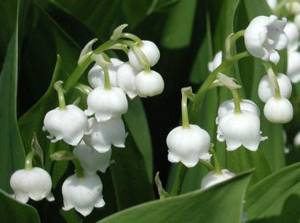
Of the diseases, garden lilies of the valley are most susceptible to gray rot, which can be gotten rid of with the help of special products sold in gardening stores. The pests of this flower are the sawfly and the onion borer. In case of infection, the diseased plant should be destroyed immediately so that it does not infect neighboring bushes.
Planting lilies of the valley and caring for the garden
When to plant lilies of the valley
If we are talking about when is the best time to plant lilies of the valley in open ground, then any gardener will answer you unequivocally: in the fall, from early September to early November. The most suitable place for them is under trees or bushes, which will create the shade they need for lilies of the valley, preventing the sun from quickly drying out the soil in the area. But remember that these plants still need light, otherwise the area will turn beautifully green, but you won’t see any flowers. And think about how to protect lilies of the valley from the wind.
Lily of the valley requires moist, slightly acidic or neutral soil, rich in organic matter. Let us remind you: in order to reduce the acidity of the soil, lime (200-300 g per 1 m²), humus or peat compost (10 kg per 1 m²), as well as fertilizers: 100 g of superphosphate and 40 g of potassium sulfate per 1 m², and you need to prepare the soil for autumn planting of lilies of the valley in the spring.
Planting lilies of the valley in autumn
Lilies of the valley are planted in rows in grooves, maintaining a distance of 10 cm between specimens, and 20-25 cm between rows. We will not describe how lily of the valley seeds are sowed: lily of the valley seeds have a very low germination rate, and such lilies of the valley grow for a very long time, and division rhizomes produces high-quality planting material - sprouts with part of the rhizome and root lobe. Some of the sprouts bear a flower bud and may bloom next spring - these are sprouts with a diameter of at least 0.6 cm with an oval tip. And those that are smaller in size and have a sharp tip next year will only be able to produce leaves.
Related article: Celosia flower: growing from seeds, photos, planting and care in open ground
The depth of the furrow should be such that the roots are placed vertically, in full length, and the sprouts are buried 1-2 cm into the ground. If the soil on the site is dry, do not forget to water the lilies of the valley after planting. With the onset of frost, cover the area with young lilies of the valley with mulch to protect them from freezing in case of a snowless winter. Lily of the valley can grow in one place without transplantation for five years.

Lilies of the valley in spring
You can plant lilies of the valley in the spring, but they can get sick and definitely won’t bloom this year. But if you prepare the area in the fall, as described above, and dig it up in the spring before planting, then the young shoots will more easily take root in the open ground, especially if you cover them with film or lutrasil at night, protecting them from spring frosts.
How to care for lilies of the valley
Lilies of the valley take care of themselves so well that they can crowd out any other flowers from the flowerbed, but for a good gardener it is not enough that the flowers grow and bloom, he needs his plants to achieve the highest decorative quality. Therefore, you will also have to pay attention to lilies of the valley: water them in hot weather so often that the soil remains moist all the time, be sure to loosen the soil and remove weeds. Lily of the valley responds well to fertilizing with organic matter - rotted manure or humus. Lilies of the valley can develop gray vegetable rot, which can be treated with fungicides.
Of all the pests, the most terrible is the nematode, from which there is no escape: diseased plants are removed and burned. This is why weed control in the area where lilies of the valley grow is so important.

